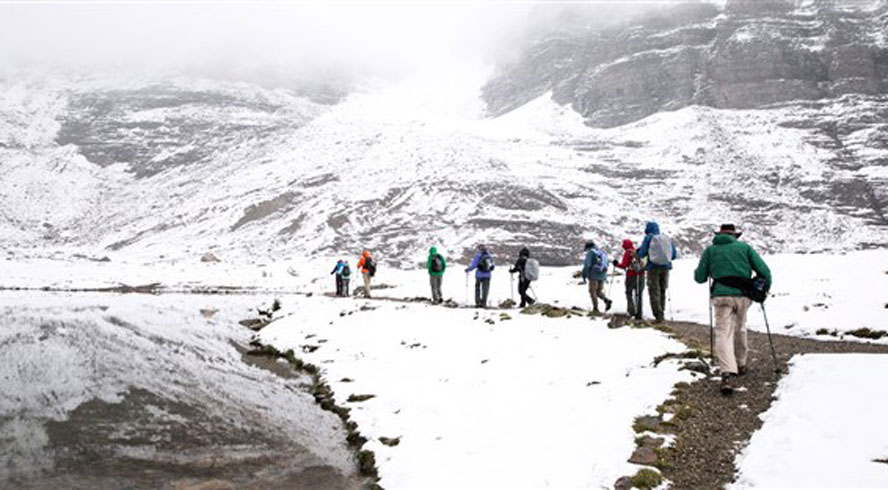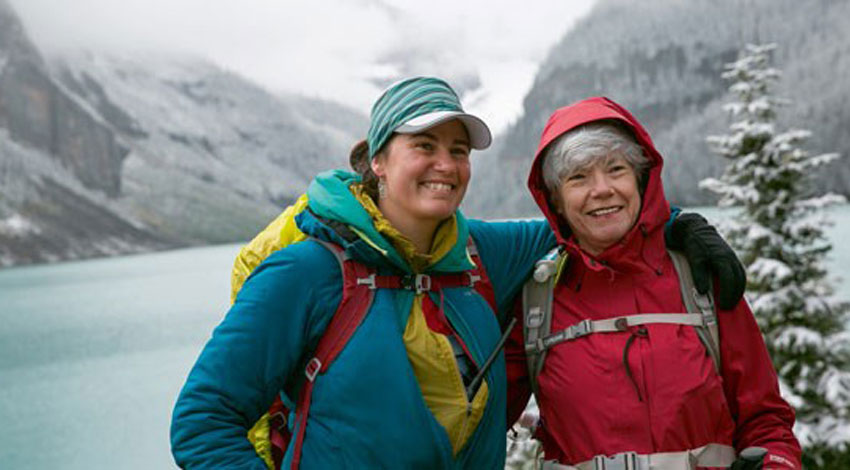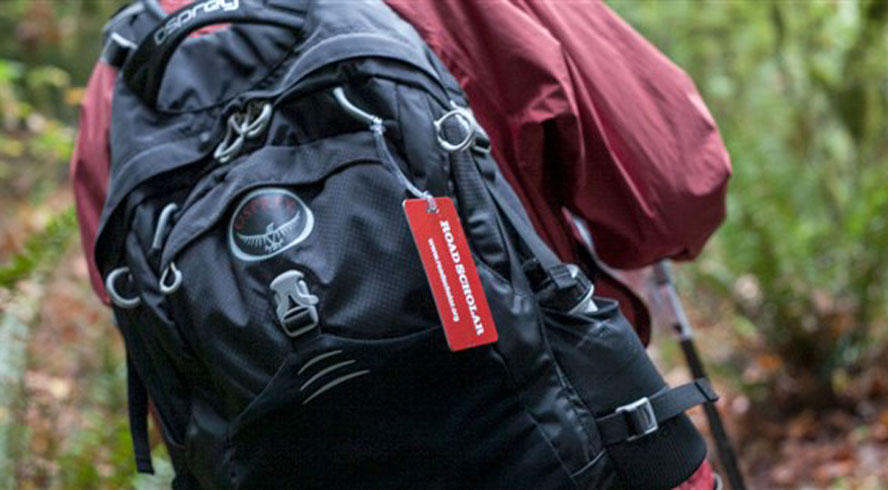11 Hiking Tips for Older Adults
“Of all the paths you take in life, make sure a few of them are dirt.” - John Muir
With the sun shining, the flowers in full bloom and the fresh summer air, now is the perfect time to head outdoors and get some exercise. Going on a hike is a great way to enjoy the warm weather and, when done regularly, can reduce arthritis, ease joint and knee pain, boost bone density, improve cardiovascular health and increase circulation. But the benefits don’t stop there – according to a University of Minnesota study, hiking can also result in a decrease of depression, isolation and loneliness, and can boost your sense of purpose.
But before you start thinking that hiking may be too difficult, don’t worry. Hiking doesn’t mean tackling Mount Everest; it’s absolutely okay to start small. You could just take a stroll through your neighborhood bike path or bring your dog on a nature trail walk. As long as you’re out in nature, you’ve gone on a hike.
So, have we convinced you to try it yet? To get started, we’ve partnered with Road Scholar instructor and expert hiker Jim Beeson to provide some hiking tips for getting you out on the trails.

1. Check With Your Doctor
Whether you’re hiking over 50 or hiking over 70, before taking on any strenuous physical activity, you should always check with your doctor to make sure you're cleared for exercise. Your doctor will be able to assess your overall health and recommend the right level of exercise to ensure you don’t overexert yourself.
Senior hiking can be dangerous if health isn’t taken into consideration, so talk to your doctor about any pain you might be experiencing, potential breathing problems and other conditions that might prevent you from hiking.
2. Prepare Appropriately
When it comes to hiking for seniors, preparation is essential for any adventure, big or small. After you’re cleared by your doctor and you’ve decided on a trail you’d like to hike, make sure you ease into the hike first. If you haven’t walked a lot lately, start going for strolls, making each one a little longer every day leading up to the hike.
Stretch before you embark on your journey, and start on smaller trails, eventually working your way up to something longer. You can also prepare for your hike by building fitness in other ways, such as doing yoga, stretching or taking senior fitness classes at a local gym.
Preparation also goes far beyond building physical fitness. It’s also important to make preparations for the hike itself, such as packing food and water, assessing the weather, wearing the right gear and more, which we’ll explore in the hiking tips for seniors below.
3. Choose the Trail That’s Right for You
As Jim says, “hike your hike.” You should never feel pressured to go beyond your comfort level, and don’t feel the need to try to keep up with your friends. If you’re hiking with someone else, do some research and choose a trail that is a good pace for both of you. Listen to your body, and don’t feel bad about taking breaks — it can be a great opportunity to take in the beautiful landscapes. Further down in our hiking tips, we’ll explore why breaks are so important.
To choose the right hike, there are a few important factors to consider to ensure your adventure goes smoothly. Take a look at these factors before heading out to the trails:
- Distance: First and foremost, consider the distance you think you’re able to hike comfortably. Whether it’s a half-mile or 2-3 miles, there are plenty of trails and routes you can choose. However, it’s important to look at the map of the trail, especially if it’s an out-and-back trail, meaning you’ll hike back the way you came. In this case, make sure the mileage is for the roundtrip, not just one way out.
- Elevation: The elevation of a hike refers to the total distance you climb in elevation, such as 1,000 feet. Looking at elevation is important, because the higher you go, the less oxygen in the air, especially for strenuous hikes in large mountains like the Rockies or Andes. However, most local hikes won’t have a high elevation gain, and hikes under 500 feet elevation should suffice for elderly hiking.
- Terrain: The terrain of a hike can make hiking for older adults more challenging, as rough terrain with rocks, roots and steep cliffs can disrupt balance and cause accidents. Before you head out on a hike, research the terrain to ensure it’s smooth and well-groomed.

4. Tell Someone Where You're Going
This is a very important hiking tip: make sure someone knows where you are going. If you’re hiking alone, it’s always a good idea to tell a friend or family member what trail you’re going on and where you’ve parked. Be as specific as possible, including estimated start and end times. You never know when an emergency can arise, especially on a senior hiking adventure, so do your due diligence by informing others of your plans. Better yet, go with a hiking partner or group. There are plenty of meet-ups available where you can meet some new friends and enjoy a hike together.
5. Check the Weather
There’s nothing worse than expecting a bright, sunny day and getting a torrential downpour. To avoid any unexpected challenges, always check the weather before you depart. Then pack everything you need for your adventure, but also don’t be afraid to cancel your trip if the weather is less than ideal. Your safety always comes first.
To adequately prepare for the weather, there are certain pieces of equipment you should pack to stay safe and comfortable on your hike.
Some useful tools, depending on whether it might possibly rain or snow, include:
- Waterproof hiking boots
- Waterproof jacket
- Waterproof or water-resistant hiking hat
- Waterproof hiking pants
- Gaiters
- Rain cover for your backpack
- Gloves
- Traction cleats for ice
Did you know? Road Scholar can help you prepare for the weather on any adventure. Check out our weather predictor on any program page under “Dates & Prices” to pick the perfect time of year for you! See it in action →
6. Wear the Right Clothing
What you wear can make or break your hike. After checking the weather, make sure you have whatever the day calls for, such as sunscreen, a hat, bug spray, a raincoat and sunglasses. Dressing in layers is a good idea because you tend to heat up when you’re hiking uphill and cool off when you’re going downhill or taking a break. Make sure you’ve got the right hiking boots as well. Jim suggests wearing about a half size bigger so your toes don’t jam up in your shoe when you’re going downhill. Not sure which boots are right for you? Check out what other active Road Scholar hikers are suggesting here.
Below are some clothing suggestions for the different seasons:
- Winter: Due to cold temperatures, make sure to wear layers of warm, waterproof clothing, such as thermal undergarments, a parka, gloves, a hat, snow pants, hiking boots and wool socks.
- Spring: As temperatures begin to rise, you can shed a few layers, such as a heavy parka. However, continue to wear several layers, as your body can heat up and cool down within the same hike. And wear waterproof garments in case of any spring showers.
- Summer: With warmer temperatures, it’s important to wear moisture-wicking clothes that are breathable and keep you cool. Make sure to pack sunscreen, sunglasses, a hat and a backpack that can carry plenty of water.
- Fall: Autumn is similar to spring, as temperatures are cooler, which means you should wear a few layers you can put on or take off during your hike to remain comfortable.

7. Handling Injuries and First Aid
Handling injuries promptly and effectively when hiking is important. To be ready for an unexpected mishap, make sure to:
- Carry a First Aid Kit: To prepare for your hike, pack a first aid kit in your backpack. (See the next section.) Ideally, you’ve taken a first aid course somewhat recently. Make sure your cell phone is fully charged before leaving for your hike.
- Stay calm when assessing an injury: Panic helps no one, so it’s important to remain calm. Try to get to a safe area to evaluate the severity of the injury. If the injury is severe, call emergency services immediately. For a minor injury, use the items in your first aid kit to stop any bleeding, clean and disinfect the wound, and cover it.
- Immobilize the injured area: If you think the injury involves a broken bone, immobilize the area around the injury using splints, bandages or clothing, and minimize movement until help can arrive.
- Elevate and apply cold compresses: Find a way to elevate the injured area to reduce swelling. Make use of your instant cold compress to minimize swelling and alleviate pain.
- Get medical help: If the injured person cannot continue on the hike, call 911 for assistance. Be prepared to describe your location to help them find you.
- Document what happened: If possible, take notes about what happened to share with emergency personnel when they arrive.
What Should Be in Your Emergency Pack
Even on a short hike, we strongly recommend you always pack a lightweight emergency kit with first aid supplies, extra food and water and a way to start a fire (like waterproof matches or a lighter). You should also make sure that your phone will get service wherever you go, or that you have a way to contact someone if you don’t get service in a particular area (flares, GPS, personal locator beacon, etc).
Here’s a list of what your emergency kit should contain:
- Bandages
- Elastic bandages
- Antiseptic wipes
- Adhesive tapes
- First aid manual
- Gauze roll and pads
- Gloves
- Emergency blanket
- Emergency contact information/medical information
- Safety pins
- Scissors
- Thermometer
- Triangular bandage
- Instant cold pack
- Tweezers
8. Drink Plenty of Water
Hydration is key for any level of exercise, especially a hike. Make sure you pack enough water, and then some extra, so you don’t find yourself dehydrated in the middle of a trail. If you’re worried about not having enough water, Jim says it’s a good idea to purchase some kind of water filtration system, like a Lifestraw, that allows you to drink directly from streams or lakes.

9. Hike in a Group
When in doubt, hike in a group. Solo hikes are great, but hiking in a group fosters camaraderie, and there’s nothing quite like the feeling when you and a bunch of your peers reach the top of that mountain. Gather your friends or try an organized group with Road Scholar, where a hiking expert will accompany you along the trails.
10. Hiking Stick for Balance and Stability
A hiking stick or trekking pole can be a great addition to your hike. It can help to provide stability over more rocky and uneven terrain. Your stick or pole should be held so that your elbows are at a comfortable 90-degree angle. You will want to experiment with movement patterns to determine what feels most comfortable. If you are carrying a single pole, you may find that moving the opposite leg of the hand that is holding the pole first is more comfortable than moving the leg next to the pole first. Practice on a hard, flat surface and see what feels more natural.

11. Recognizing When To Rest
Hiking can be more strenuous than it seems, especially when walking on a relatively flat trail that doesn’t pose a significant change in elevation. It’s extremely important to listen to your body and know when it’s time for a break.
Here are some indicators to help you know when it’s time to take a break:
- You are feeling fatigued - If you’re feeling tired, it’s time for a break. Being overly tired while hiking can lead to accidents, so it's best to rest sooner than later.
- You’re having trouble catching your breath - If you’re breathing heavily or feeling short of breath while not on a strenuous climb, it’s your body’s way of telling you it needs a break. Give it a chance to catch up.
- Your heart is beating too fast - Many exercise wearables will let you measure your heart rate. If it’s beating too fast for too long, it could lead to problems. Stop and take a break. If you’re not sure what a good exercising heart rate is, consult your doctor to find out the right range for you based on your age.
- You are experiencing cramps - If you are experiencing cramping in your legs or feel weak or shaky, it’s time to stop and refuel with some water and maybe a snack. Muscle cramping can be a sign of an electrolyte imbalance or dehydration, so it’s especially important to stop and hydrate 1zif this is happening.
- Altered coordination or balance - As a senior hiking the trails, it’s especially important to be aware if you’re feeling off balance. It’s time to rest if this is happening because if you continue, it could lead to an accident.
- Change in mental status - If you’re feeling lightheaded or dizzy, stop immediately and don’t continue until the feeling subsides.
Check out all of Road Scholar's Walking & Hiking Adventures!
About Jim Beeson
As President of the Roanoke Appalachian Trail Club, Jim Beeson is dedicated to maintaining the Appalachian Trail and has a lot of experience hiking through its woods. In 2016, at age 61, Jim hiked the entire Appalachian Trail from Springer Mountain, Ga. to Mt. Katahdin, Maine — over 2,000 miles and 14 states in just 5 ½ months. He’s currently a Road Scholar instructor for several hiking programs, including Hiking the Blue Ridge Mountains of Virginia.
